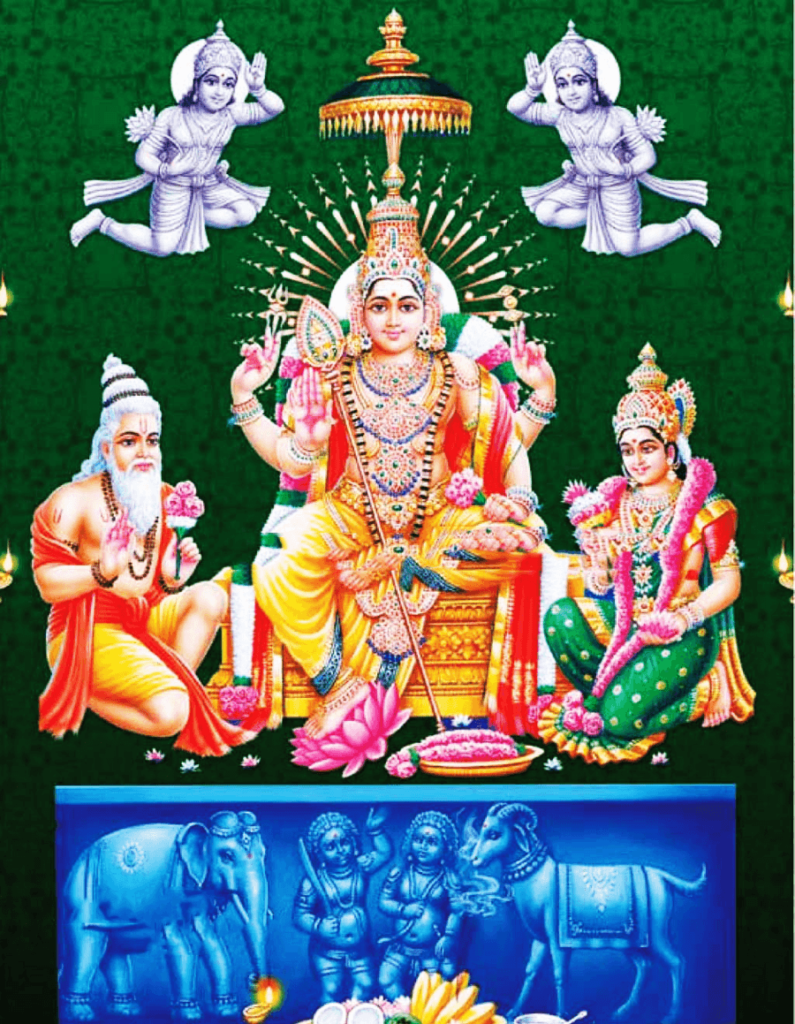Thiruparankundram Murugan Temple or Subramanya Swamy Temple is a Hindu temple and one of the Six Abodes of Murugan, located at Thiruparankundram. The temple is built in rock-cut architecture and believed to have been built by the Pandyas during the 6th century. According to the legend it is where Murugan slayed the demon Surapadman and married Deivayanai, the divine daughter of the king of heaven, Indra, and he is said to have worshipped Shiva here as Parangirinathar.
The temple is located 8 kilometres (5.0 mi) from Madurai in India. In the main shrine, apart from Muruga, deities of Shiva, Vishnu, Vinayaka and Durga are housed. The temple follows Shaivite tradition of worship. Six daily rituals and three yearly festivals are held at the temple, of which the Kantha Sashti festival during the Tamil month of Aippasi (October – November) being the most prominent.


Thiruparamkundram finds mention in Kanda Puranam detailing the slaying of Surapadman by Muruga. As per Hindu legend, Surapadma, a demon king, once obtained boons from Shiva on account of severe penance. He started ruling the 1008 worlds on account of the power attained. He married Padumakomalai and had several sons. Viramkendiram became his capital, a city created in the seas and he started troubling the Devas. He imprisoned Indra (the king of celestial deities) and also desired his wife Indrani. Indra sought the help of Muruga. Muruga sent his messenger Viravakutevar to the demon, but he was unmoved. A severe battle was fought in Thiruparamkundram where Muruga killed all the sons of the demon except Iraniyan. Surapadman hid under the sea and Muruga split him into two pieces, which went on the become the divine vehicles, peacock and rooster. The day when Muruga slayed Surapadma is celebrated as Skanda Sashti festival in all the Murugan temples.
Indra, the king of Devas was impressed and he married Deivayanai, his divine daughter to Muruga at Thiruparamkundram. Muruga is believed to have worshipped Shiva here as Parangirinathar. Kanthar Anoobothi, a treatise of the divine marriage records that Muruga asked all the divine angels and gods who attended the marriage to fly back to heaven in their own vehicles in Mano veham (speed of thought).
The temple is built rock-cut architecture dating back to the Pandya period of 6th century and the life sized sculptures in the mandapas of the Nayaka period during the 16th century. An Aasthaana Mandapa with several artistically carved pillars lead one to the towering 150 feet (46 m) high seven-tiered rajagopuram at the entrance.[4] The granite hill behind the temple is 1,050 ft (320 m) has a shrine of Kasi Viswanatha at the top. The image of Vinayaka in the temple in the temple is sported holding sugarcane and fruits.
The Kambathadi Mandapam, Ardha Mandapam, and Mahamandapam, the three halls leading to the sanctum, are situated at varying elevation. The main shrine is an early rock cut temple which has cells that house the sanctums of Subramanya, Durga, Vinayakar, Shiva and Vishnu. All the statues are carved on the wall of the parankundram rock. The presiding deity shiva is known Parangirinathar and the female deity his consort Parvathi is known as Aavudai Nayaki. Panels depicting Shiva’s dance of bliss are seen outside the sanctum.
A notable feature of this temple is that the Shiva and Vishnu face each other in the main shrine, considered a rare thing in ancient Hindu temples. Outside the temple there is tank, where according to the temple tradition, the fishes are served with salt and rice flakes by the devotees. There is also a Vedic school adjacent to the banks of the temple pond. In front of the Dwajasthambam, the flag staff, there is a carved Nandi, Mayil (peacock) and Mouse (the vehicle of Ganesha). There is a flight of six steps called the “Shadashara Padigal”, before Ardha Mandapam. The rock carvings of Mahisshasura Mardini, Karpaga Vinayagar, Andarabaranar and Uggirar are seen in the hall. There are five divine water bodies, namely, Saravana Poigai, Lakshmi Theertham, Saniyasi Kinaru (well), Kasi Sunai, and Sathiya Koopam
Skanda Shashti festival celebrated during the Tamil month of Aippasi (October – November) is the most prominent festival of the temple. Muruga killing Surapadma is enacted during the last of the six days and the festive image of Muruga is taken in different mounts around the streets of the temple during the festival. Brahmotsavam here falls in the Tamil month of Panguni. The Vishnu named Pavalakanivai Perumal, and Muruga are taken in procession to Madurai to celebrate Minakshi’s wedding (Chittirai festival), with residents of Madurai dressed in festive clothing. Nakkirar’s association with this temple is also celebrated as a festival. Karthigai Deepam festival is also celebrated during the Tamil month of Karthigai by lighting a lamp on top of the hill. Vaikasi Visakam, and the float festival in Thai(Tamil month) are the other festivals celebrated in the temple. Since the image of Vishnu is in the temple, Vaikunta Ekadashi is also celebrated.
